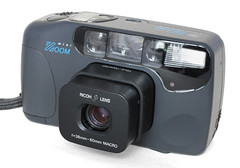Ricoh Myport Zoom mini

|
| Myport zoom mini image by nik.jalopx (Image rights) |
The Myport Zoom mini is an autofocus compact camera for 35mm film, introduced by Ricoh in 1992 as the world's smallest[1] 35mm compact camera with a zoom lens. This camera was distinctly smaller than the most compact zoom cameras of the day, it was even smaller than the many fixed focal-length compact cameras. The Myport Zoom mini was hailed as the first ever true shirt-pocketable zoom when it was introduced.
Apart from its remarkable body size, this camera has some very unique features such as the Continuous Shooting mode (1 frame/s), Super-Night mode, TV mode, or the Remote Control capabilities.
The camera is also known as the Shotmaster Ultra Zoom or FF-10 Zoom. The Myport Zoom mini P[2] is a variant model with the addition of 'panorama' feature. Myport Zoom mini PS / FF-10S Zoom / Shotmaster Ultra Zoom II are the updated models with the red-eye reduction feature. The camera was also sold by Boots as the Mini Zoom.
Myport Zoom mini series cameras were made in Japan and Taiwan.
Successor Models : Myport Zoom 320P, FF-20 Wide Zoom, Shotmaster Ultra Zoom Super

|
| Boots-branded version image by AWCam (Image rights) |
Specifications
- Release Date: Februaly 1992
- Lens: 38mm f/4.5 - 60mm f/6.9, 1.6X Zoom, 5 elements in 5 groups
- Focus: Active spot AF, 30 focusing steps, 0.6m - inf. (at telephoto), 0.8m - inf. (at wide angle)
- Shutter: 1 sec. (Super-Night mode), 1/4 -1/300 sec. (Normal mode)
- Film Speed Range: ISO 64 - 3200 (DX-code system)
- Bult-in Flash: G.N. 19m (ISO 100), Auto Fill-in, Auto / On / Off
- Other Features: Continuous Shooting mode, TV mode, Super-Night mode, Remote Control socket, Film door safety lock
- Power Source: 3V Lithium Battery (CR-123A)
- Diminsions: 119.2mm X 66.5mm X 40.0mm
- Weight: 230 g (without battery)
Notes
- ↑ List of All Ricoh Cameras on Ricoh official website (in Japanese)
- ↑ There are two versions of Myport Zoom mini P. Those manufactured in the later period of its production had the red-eye reduction mode, while those manufactured in the earlier period did not. They are distinguishable by the presence of the second small circular window beneath the flash.
Links
- Myport Zoom mini on Ricoh official website (in Japanese)
- Myport Zoom mini' on Ricoh official website camera library (in Japanese)
- Shotmaster Ultra Zoom Manual on Mike Butkus' site